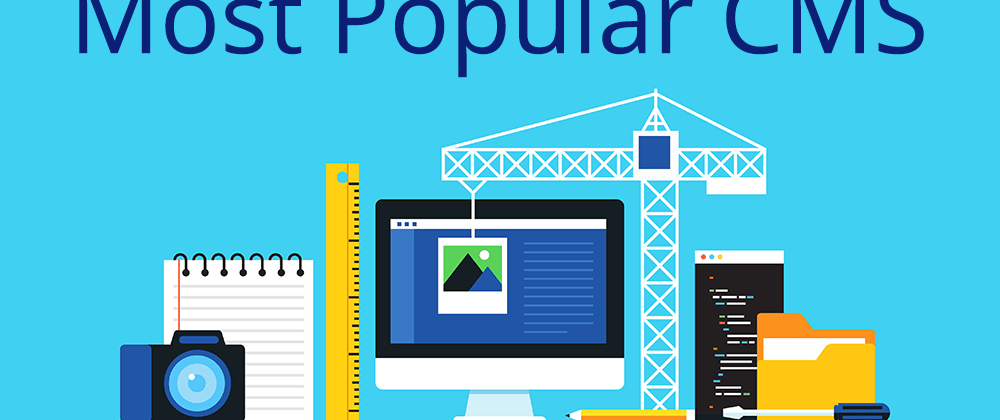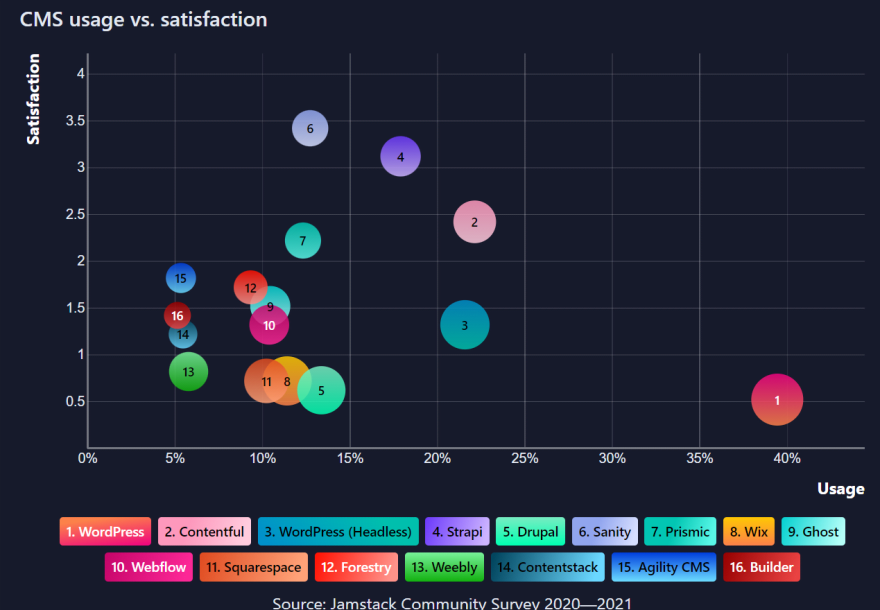Popularity contests aren’t necessarily the best way to judge a piece of technology.
However, popularity is still important because it can be an indication of how well a piece of tech works.
If others in your field are using it – and they have good things to say about it – then it’s probably worth checking out.
Let’s take a look at content management systems today, including what they are, how they work and then how popular they are among professionals today.
CMS definition
Content management systems are one of the simpler things in the tech world because they are exactly what the name suggests: A place to manage content.
That means the backend structure of a website, where you as the creator log in and get to work. The visitors of your website will never see this space, it’s just for you and your team.
Inside, you’ll find a place to write blogs in a text editor box. If you’re lucky, the CMS you choose will have a text editor which is similar to Microsoft Word and intuitive to use. Or maybe you don’t really need a blog, you just want a place to show off your photos. There’s a spot to upload, edit and store your photos inside the CMS, and then display them on the frontend of the site whenever you’d like to publish.
Another popular option for CMS users is a place to sell things, or e-commerce. Some CMS solutions – like Shopify and Squarespace – are oriented around selling goods, but many CMS platforms offer ways to set up an e-commerce store online using something like Snipcart. You can add pictures of products, descriptions for each one and then set up an inventory as well.
CMS users
Who are the people using CMS? Well, they are wide-ranging.
Bloggers looking for a place to write their content – and have no limitations as to the topics – may look to start their own blog by using a CMS. Many use WordPress – 35% of the world’s websites are powered by it – but there are a whole host of options, as we explain a little later.
People have expertise, and they want to share what they know. It could be about sports, gardening, tech, politics, or just updates on their family and what everyone’s been up to lately, “Sarah started movie camp this summer and loved it!”
Certainly, photographers are another group of people who may turn to CMS solutions to post their work online. Look, Facebook or Instagram may work for this, too, but with your own website you can share all of your work in one place and even set up a way for folks to purchase prints and/or originals if you choose.
Following that same train of thought, small business owners will likely turn to a CMS like Shopify or Squarespace due to their leaning towards being selling platforms. List products, tell your story and what your company does, and connect with customers by using a CMS.
But small businesses aren’t the only ones looking to use CMS solutions, big businesses are too.
Many times, marketing professionals – like content creators or marketing coordinators etc. – are looking for a solid CMS to host the company blog. Just like anyone with their personal blog, companies can and do import photos for their blogs and write content, publishing through the CMS and making it visible on their website for the public to consume.
Simply, content is king. Content helps businesses get discovered. And it allows businesses to describe what they do to the world, in turn, being sought out and then hopefully growing from there.
So, now that we know what CMS do and who uses them, let’s look at the best ones available today.
CMS popularity and satisfaction
Off the bat, it should be noted that the people who were asked about these CMS were developers. It’s an interesting group to ask because, while they do use them, CMS seem to be more closely linked to marketing people than to devs.
Nonetheless, we have our results.
According to Jamstack.org’s survey , we see some interesting, some unsurprising, and some shocking results.
Looking at the graph above, what we see is those further right are used more, left are used less. The ones at the top of the graph are enjoyed more by users, while the ones scoring 1 or less on the scale are CMS which people want to stop using altogether.
Unsurprisingly, WordPress is the most widely used CMS out there. We’ve written extensively about WordPress’ popularity as a back end, but many people are turning to headless WordPress due to rigid options offered by the platform. And headless WordPress scores much higher on the satisfaction scale, at a 1.3.
However, WordPress earned a score of 0.3 on the satisfaction scale, meaning people really want to move away from using it. That’s similar to Drupal, Wix, Squarespace and Weebly: All four of them have satisfaction scores under 1, meaning developers would rather be done using them.
Interestingly, we recently wrote about how people should look for no-code tools which have hosting flexibility: Squarespace, Wix and Weebly are all platform dependent. The downsides of using platforms which lock you in for hosting is they set the pricing, and price increases, they can change features at any time and so on.
Next up, there are some intriguing options in the middle of the pack on the graph, with high satisfaction scores. Contentful (2.3), Strapi (3.2) and Sanity (3.4) all score very high in that realm, while each increased in usage from 2020-21. While Strapi and Sanity are relatively newcomers onto the scene – both of them really getting off the ground in 2020 – Contentful is a well-known player in the CMS universe. In fact, behind WordPress and headless WordPress, Contentful is the most-used platform studied here, at 22% of those polled using it.
At the back of the pack, there’s a whole group of CMS which aren’t being used much, but they all do have a positive satisfaction score, at least. Those are Webflow, Ghost, Forestry, Contentstack, Agility and Builder.
Conclusion
Like JavaScript frameworks, there are a ton of CMS choices in the world. And depending on your project at hand, there are a whole host of options in terms of which one will fit for you.
If you’re writing a blog, WordPress can be a solid option. But due to the many plugins needed to create a great site, we’d recommend using a headless WordPress solution instead (which scored much higher on satisfaction ratings).
If you’re looking to sell things, Shopify and Squarespace are certainly options. However, they lock you in with platform dependency, and we believe you should search for options with open hosting instead. That way, you won’t get locked into price hikes for services, changing features etc.
Of course, the other options – Contentful, Strapi and Sanity, among others – all have e-commerce abilities, too, with much-higher satisfaction scores. So, trying out one of those three could be the best option, but again, you should dig in and do some research depending on what you’d like to do on your site.
And once you do choose the right CMS, bring it to Fathym to host (if it is an open-hosting CMS, which again, we recommend).
You can join Fathym today for free. Start building your new website and get it live in less than a day, it’s really that easy!








Latest comments (0)